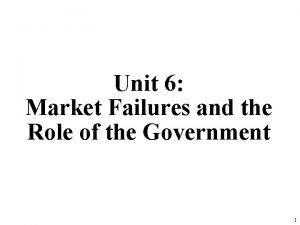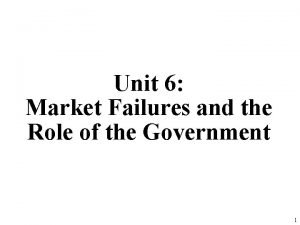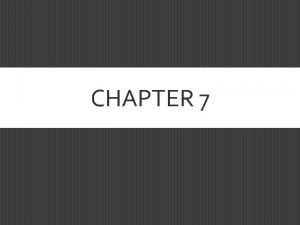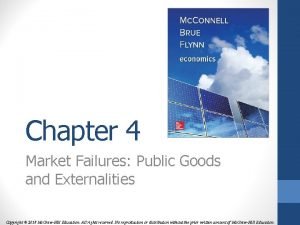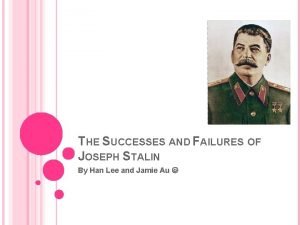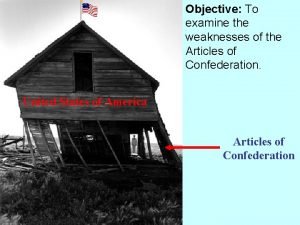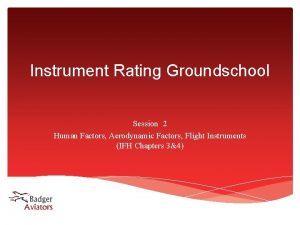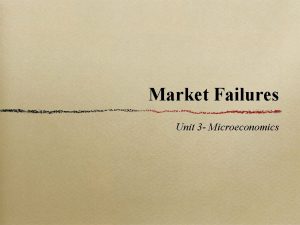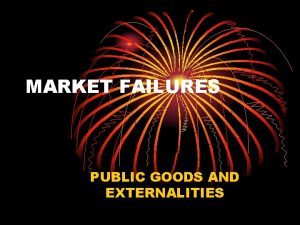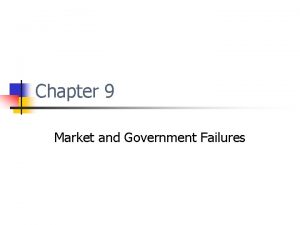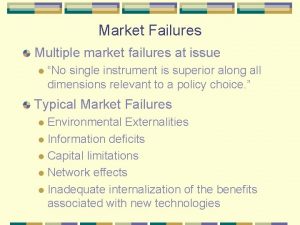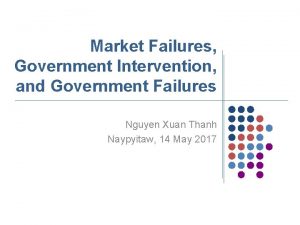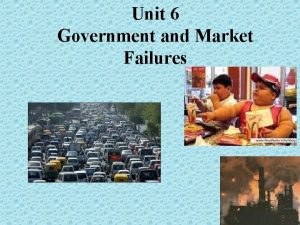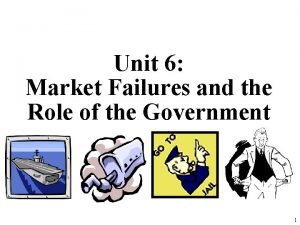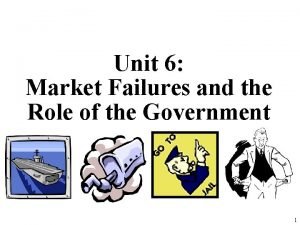Unit 6 Market Failures and the Role of













- Slides: 13

Unit 6: Market Failures and the Role of the Government 1

Review 1. List the characteristics of the Free Market. 2. Define Market Failure. 3. What is the “invisible hand”? 4. List the 4 Market Failures. 5. Why must the government provide public goods? 6. Define Free Rider. 7. What is wrong with having free riders? 8. List 10 college degrees. 2

Market Failure #1 PUBLIC GOODS Why doesn’t the free market provide them? There is little opportunity to earn profit. Why NOT? Individuals benefit without paying. 3

How do we decide how many public goods we need? 4

Can the government… 1. Prevent wild fires in San Diego forever? 2. Ensure that no one ever speeds on the freeway? 3. Create a research station on Mars? 4. Stop pollution from fossil fuels? 5. Completely stop illegal immigration? 6. Make sure everyone in the US has a job? YES! But the costs outweigh the benefits. How does the government decide how many public goods to provide?

How does the government determine what quantity of public goods to produce? They use Supply and Demand for Public Goods. The Marginal Social Benefit of the good determined by citizens willingness to pay. Supply of Public Goods. The Marginal Social Cost of providing each additional quantity. Video: Dam Tragedy

Demand for a New Park Marginal willingness to pay higher taxes # of Parks 1 2 3 4 5 Assume: Marginal Adam is Jill is Society’s willing to Demand Cost 1. There are only pay for Parks two people in $4 $3 $2 $1 $0 $5 $4 $3 $2 $1 society. $5 $9 2. Each additional $7 $5 park costs $5 $5 $5 How many parks $3 $5 should be made? $1 $5

Demand for a New Park Marginal willingness to pay higher taxes # of Parks 1 2 3 4 5 Adam is Jill is Society’s Marginal willing to Demand Cost pay for Parks $4 $3 $2 $1 $0 + + + $5 $4 $3 $2 $1 = = = $9 The $5 $7 Marginal$5 Societal $5 Benefit $5 $3(MSB) $5 $1 $5

Demand for a New Park Marginal willingness to pay higher taxes # of Parks 1 2 3 4 5 Adam is Jill is Society’s Marginal willing to Demand Cost per pay (MSB) Park $4 $3 $2 $1 $0 $5 $4 $3 $2 $1 $9 $7 $5 $3 $1 $5 $5 $5

Demand for a New Park Marginal willingness to pay higher taxes # of Parks 1 2 3 4 5 Adam is Jill is Society’s Marginal willing to Demand Social pay (MSB) Cost $4 $3 $2 $1 $0 $5 $4 $3 $2 $1 $9 $7 $5 $3 $1 $5 $5 $5

Supply and Demand for Public Parks Price The Demand is equal to the marginal benefit to society $9 7 5 3 1 D=MSB 0 1 2 3 4 Quantity of Parks 5

Supply and Demand for Public Parks 1. What if the government made 1 park? 2. What if the government made 4 parks? Price $9 7 MSB = MSC S=MSC 5 The supply is the public good’s marginal cost to society 3 1 0 1 2 D=MSB 3 4 Quantity of Parks 5

Video: Defending the Free Market System 13
 Unit 6 market failures and the role of the government
Unit 6 market failures and the role of the government Unit 6 market failures and the role of the government
Unit 6 market failures and the role of the government Chapter 7 section 1 guided reading
Chapter 7 section 1 guided reading Define market failures
Define market failures Supply side market failures occur when
Supply side market failures occur when Public goods
Public goods Types of market failure
Types of market failure Marketing targeting and positioning
Marketing targeting and positioning Market leader challenger follower nicher examples
Market leader challenger follower nicher examples Successes and failures of the five year plans
Successes and failures of the five year plans C# azure worker role example
C# azure worker role example Articles of confederation fail
Articles of confederation fail Engineering ethics failures
Engineering ethics failures Vsi calibrated leak
Vsi calibrated leak
